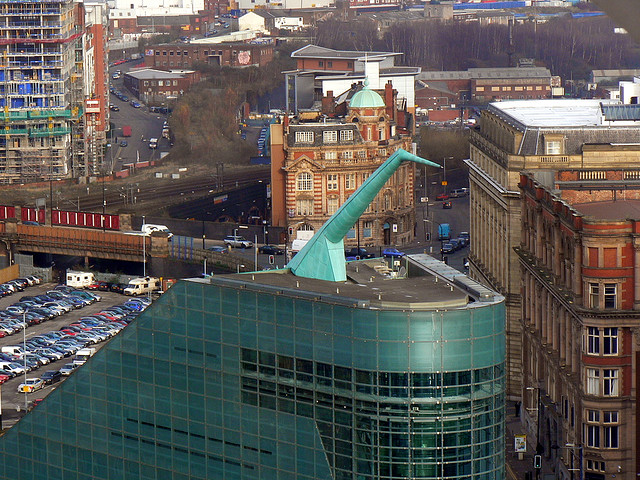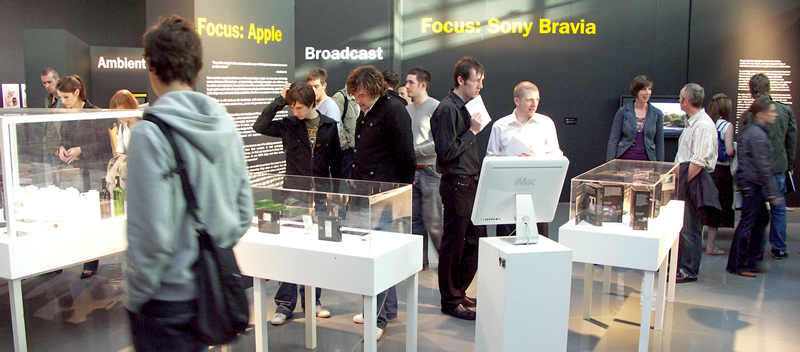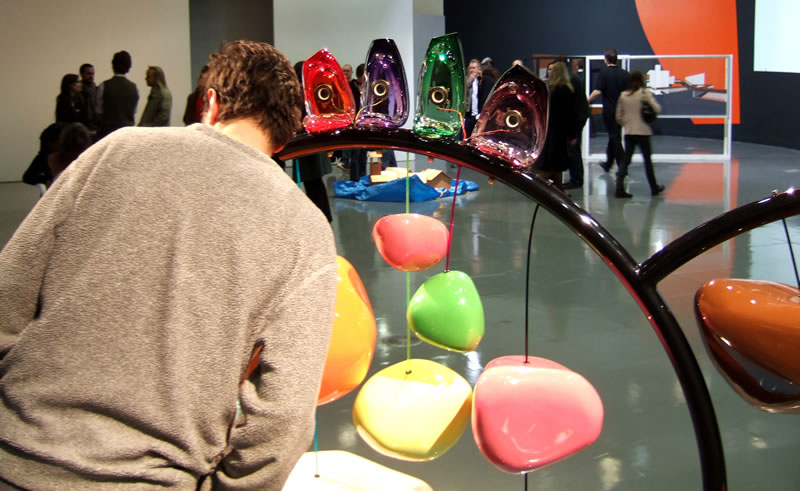Urbis on:
[Wikipedia]
[Google]
[Amazon]
Urbis was an exhibition and museum in Manchester, England, designed by Ian Simpson. The building opened in June 2002 as part of the redevelopment of Exchange Square known as the Millennium Quarter. Urbis was commissioned as a 'Museum of the City' but visitor numbers were lower than expected and a switch was made in 2005-6 to presenting changing exhibitions on popular-culture alongside talks, gigs and special events. Urbis was closed in 2010, after the opportunity arose for Manchester to host the National Football Museum. In 2012, the building re-opened after a complete re-fit as the permanent

 Urbis is a building in
Urbis is a building in
 ;2009
''State of Art: New York'' from April to September showcased contemporary art in New York.
''Videogame Nation'' charted the rise of video games over four decades, how it became a multibillion-pound industry and the Wii and Nintendo DS.
''The Best of Manchester Awards 2009'' celebrated Mancunian culture in 2009.
''Home Grown: The Story of UK Hip Hop'', from October 2009 to February 2010, documented the hip-hop music scene.
''Manchester, Television & the City: Ghosts of Winter Hill'' explored the city's television industry,
;2009
''State of Art: New York'' from April to September showcased contemporary art in New York.
''Videogame Nation'' charted the rise of video games over four decades, how it became a multibillion-pound industry and the Wii and Nintendo DS.
''The Best of Manchester Awards 2009'' celebrated Mancunian culture in 2009.
''Home Grown: The Story of UK Hip Hop'', from October 2009 to February 2010, documented the hip-hop music scene.
''Manchester, Television & the City: Ghosts of Winter Hill'' explored the city's television industry,  *Under Surveillance
*British Art Show 6
*Little Black Dress
*D&AD: The Best Advertising Design in the World
*Manchester 0161: This is what we're made of
*The China Show
*Make Me Shine
;2005
*Rock 'n' Roll Icons: the photography of Mick Rock
*Punk: Sex, Seditionaries and the Sex Pistols
*SuperCity
;2004
*Manchester 24
*ILL COMMUNICATION II
*DTroit
*The Sounds of Two Cities
*Futuresonic04
*The Peter Saville Show
;2003
*Compost Cities
*Ill Communication
*Taxi!
*Heliodays in the rainy city
;2002
*Architecture by Stealth
*Under Surveillance
*British Art Show 6
*Little Black Dress
*D&AD: The Best Advertising Design in the World
*Manchester 0161: This is what we're made of
*The China Show
*Make Me Shine
;2005
*Rock 'n' Roll Icons: the photography of Mick Rock
*Punk: Sex, Seditionaries and the Sex Pistols
*SuperCity
;2004
*Manchester 24
*ILL COMMUNICATION II
*DTroit
*The Sounds of Two Cities
*Futuresonic04
*The Peter Saville Show
;2003
*Compost Cities
*Ill Communication
*Taxi!
*Heliodays in the rainy city
;2002
*Architecture by Stealth
National Football Museum
The National Football Museum is England's national museum of football. It is based in the Urbis building in Manchester city centre, and preserves, conserves and displays important collections of football memorabilia.
The museum was originally b ...
.
Architecture and design

 Urbis is a building in
Urbis is a building in Cathedral Gardens
Cathedral Gardens is an open space in Manchester city centre, in North West England. It is bounded by Victoria railway station to the north, Chetham's School of Music to the west, the perimeter of Manchester Cathedral and the Corn Exchange on Fen ...
, designed by Simpson Haugh and Partners with consulting engineers Martin Stockley Associates. The building has six storeys and a distinctive sloping form. Visitors were intended to travel to the top floor, accessed by a lift, to admire the cityscape, then progress down a series of cascading mezzanine
A mezzanine (; or in Italian, a ''mezzanino'') is an intermediate floor in a building which is partly open to the double-height ceilinged floor below, or which does not extend over the whole floorspace of the building, a loft with non-sloped ...
floors past exhibits about cities. The fully glazed facades consist of approximately 2,200 glass panes arranged in horizontal strips. The building has an adiabatic cooling system for use in summer and heat recovery system for use in winter increasing its energy efficiency.
History
Urbis, a museum and exhibition centre intended to showcase inner-city life, opened on 27 June 2002 as a symbol of regeneration after the IRA's1996 Manchester bombing
The 1996 Manchester bombing was an attack carried out by the Provisional Irish Republican Army (IRA) on Saturday, 15 June 1996. The IRA detonated a lorry bomb on Corporation Street in the centre of Manchester, England. It was the biggest ...
. The project attracted £30 million funding from the Millennium Commission and £1 million from Manchester City Council
Manchester City Council is the local authority for Manchester, a city and metropolitan borough in Greater Manchester, England. Manchester is the sixth largest city in England by population. Its city council is composed of 96 councillors, three f ...
towards the running costs. The exhibition space covered five floors and hosted temporary exhibitions running for between three and five months.
The museum's first director, Elizabeth Usher, resigned in March 2003 amid criticism that Urbis was not appealing and the exhibits were too abstract. First-year visitor figures fell 58,000 short of its 200,000 target and the Millennium Commission, who provided £20m of funds, threatened to reclaim its money if Manchester City Council had to close it.
Visitors paying a £5 admission fee were unimpressed and few visitors returned, which the management saw as a key problem. By October 2003, visitor numbers were below 200 a day and there was criticism over a £2m annual subsidy from Manchester City Council, '' The Guardian'' architecture critic Deyan Sudjic remarked that the exhibits were a "spectacular missed opportunity", although Urbis did garner some praise in other quarters.
In an attempt to boost visitor figures, the admission fee was scrapped in December 2003. The plan worked: visitor figures trebled by January 2004 steadily increasing to fivefold by April 2004.
Urbis' chief executive admitted in 2010 that the 'Museum of the City', which ran from 2002 to 2004, "just didn't work". In 2004, a radical decision was taken to rebrand Urbis as an exhibition centre for British popular culture with emphasis on Manchester and no longer called a museum in an attempt to give it a clear identity. With no admission fee, Urbis shook off its white elephant title as visitor numbers rose and over a quarter of visitors came from outside the city.
National Football Museum
Urbis closed in February 2010 for conversion to theNational Football Museum
The National Football Museum is England's national museum of football. It is based in the Urbis building in Manchester city centre, and preserves, conserves and displays important collections of football memorabilia.
The museum was originally b ...
. Plans to relocate the National Football Museum from Preston
Preston is a place name, surname and given name that may refer to:
Places
England
*Preston, Lancashire, an urban settlement
**The City of Preston, Lancashire, a borough and non-metropolitan district which contains the settlement
**County Boro ...
in Lancashire had emerged in 2009. Retrieved on 21 December 2009. The museum trustees cited long-term funding worries as the reason for relocating to Manchester where 400,000 visitors a year – four times the previous figure – are expected.
Preston City Council, unhappy at the proposals, attempted to thwart the move. The University of Central Lancashire
, mottoeng = "From the Earth to the Sun"
, established = as Institution for the Diffusion of Useful Knowledgere-established 1992 (University status granted)
, type = Public
, chancellor ...
, Lancashire County Council
Lancashire County Council is the upper-tier local authority for the non-metropolitan county of Lancashire, England. It consists of 84 councillors. Since the 2017 election, the council has been under Conservative control.
Prior to the 2009 La ...
and Preston City Council offered the museum £400,000 per year but were outbid by Manchester City Council
Manchester City Council is the local authority for Manchester, a city and metropolitan borough in Greater Manchester, England. Manchester is the sixth largest city in England by population. Its city council is composed of 96 councillors, three f ...
's £2 million. Admission is free and a broad advertising campaign will aim to attract visitors to Urbis. In the first 9 months of opening, the museum had already attracted 350,000 visitors.
History of exhibitions and events
 ;2009
''State of Art: New York'' from April to September showcased contemporary art in New York.
''Videogame Nation'' charted the rise of video games over four decades, how it became a multibillion-pound industry and the Wii and Nintendo DS.
''The Best of Manchester Awards 2009'' celebrated Mancunian culture in 2009.
''Home Grown: The Story of UK Hip Hop'', from October 2009 to February 2010, documented the hip-hop music scene.
''Manchester, Television & the City: Ghosts of Winter Hill'' explored the city's television industry,
;2009
''State of Art: New York'' from April to September showcased contemporary art in New York.
''Videogame Nation'' charted the rise of video games over four decades, how it became a multibillion-pound industry and the Wii and Nintendo DS.
''The Best of Manchester Awards 2009'' celebrated Mancunian culture in 2009.
''Home Grown: The Story of UK Hip Hop'', from October 2009 to February 2010, documented the hip-hop music scene.
''Manchester, Television & the City: Ghosts of Winter Hill'' explored the city's television industry, Granada Television
ITV Granada, formerly known as Granada Television, is the ITV franchisee for the North West of England and Isle of Man. From 1956 to 1968 it broadcast to both the north west and Yorkshire but only on weekdays as ABC Weekend Television was its ...
, BBC North
BBC North (Group) is an operational business division of the BBC.
It is also a brand that has been used by the BBC to mean:
*The large ''BBC North'' region, centred on Manchester, that was active from the late 1920s until 1968 and was based ...
and programmes created in Manchester. The exhibition coincided with the digital switchover in the region and television's move to MediaCityUK.
;2008
''The Manchester Zinefest'' was about independent publishing and zines.
''How Manga Took Over The World'' explored how Manga, influenced 21st-century art culture. ''Reality Hack: Hidden Manchester'', atmospheric photographs of Manchester's abandoned recesses by Andrew Brooks and curated by Andy Brydon.
''Urban Gardening'' featured gardening in urban environments.
'' Emory Douglas retrospective'' exhibited the work an artist involved with the Black Panther organisation.
;2007
*The Haçienda
The Haçienda was a nightclub and music venue in Manchester, North West England, which became famous during the Manchester years of the 1980s and early 1990s. It was run by the record label Factory Records.
The club opened in 1982, eventually ...
25 The Exhibition: Fac 491
*D&AD Exhibition: The Best Design and Advertising in the World
*Catapult 07
*Arrivals & Departures: New Art Perspectives of Hong Kong
*PLAY: Experience the Adventure of Our Cities
*City 'til I Die?
*Best of Manchester
* Bog Standard Gallery
;2006
 *Under Surveillance
*British Art Show 6
*Little Black Dress
*D&AD: The Best Advertising Design in the World
*Manchester 0161: This is what we're made of
*The China Show
*Make Me Shine
;2005
*Rock 'n' Roll Icons: the photography of Mick Rock
*Punk: Sex, Seditionaries and the Sex Pistols
*SuperCity
;2004
*Manchester 24
*ILL COMMUNICATION II
*DTroit
*The Sounds of Two Cities
*Futuresonic04
*The Peter Saville Show
;2003
*Compost Cities
*Ill Communication
*Taxi!
*Heliodays in the rainy city
;2002
*Architecture by Stealth
*Under Surveillance
*British Art Show 6
*Little Black Dress
*D&AD: The Best Advertising Design in the World
*Manchester 0161: This is what we're made of
*The China Show
*Make Me Shine
;2005
*Rock 'n' Roll Icons: the photography of Mick Rock
*Punk: Sex, Seditionaries and the Sex Pistols
*SuperCity
;2004
*Manchester 24
*ILL COMMUNICATION II
*DTroit
*The Sounds of Two Cities
*Futuresonic04
*The Peter Saville Show
;2003
*Compost Cities
*Ill Communication
*Taxi!
*Heliodays in the rainy city
;2002
*Architecture by Stealth
See also
*Cathedral Gardens
Cathedral Gardens is an open space in Manchester city centre, in North West England. It is bounded by Victoria railway station to the north, Chetham's School of Music to the west, the perimeter of Manchester Cathedral and the Corn Exchange on Fen ...
References
External links
{{Coord, 53, 29, 08, N, 2, 14, 31, W, type:landmark, display=title Museums in Manchester Buildings and structures in Manchester Tourist attractions in Manchester